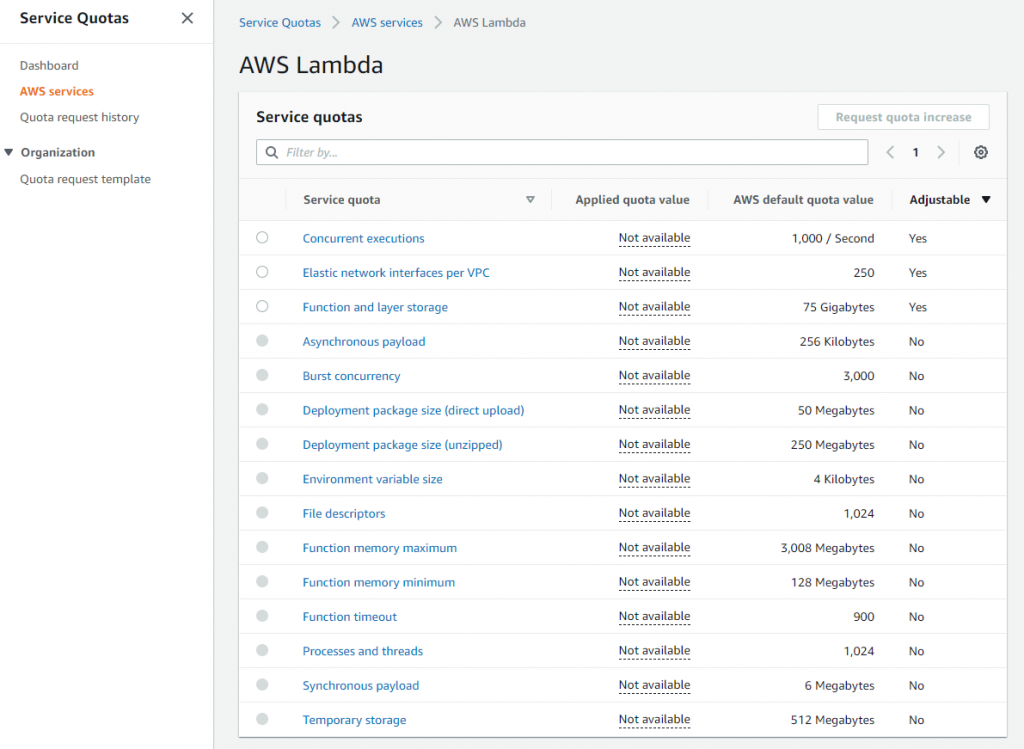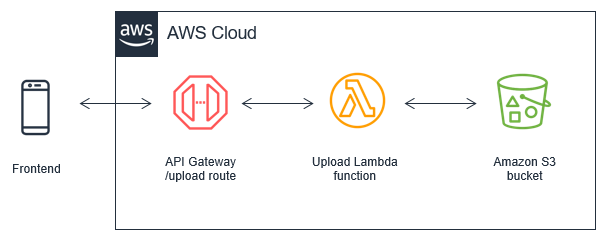AWS Compute Blog
Operating Lambda: Application design and Service Quotas – Part 1
In the Operating Lambda series, I cover important topics for developers, architects, and systems administrators who are managing AWS Lambda-based applications. This three-part series discusses application design for Lambda-based applications.
A well-architected event-driven application uses a combination of AWS services and custom code to process and manage requests and data. This series on Lambda-specific topics in application design, and how Lambda interacts with other services. There are many important considerations for serverless architects when designing applications for busy production systems.
Part 1 shows how to work with Service Quotas, when to request increases, and architecting with quotas in mind. It also explains how to control traffic for downstream server-based resources.
Understanding quotas
The Lambda service is designed for short-lived compute tasks that do not retain or rely upon state between invocations. The Lambda service invokes your custom code on demand in response to events from other AWS services, or requests via the AWS CLI or AWS SDKs. Code can run for up to 15 minutes in a single invocation and a single function can use up to 10,240 MB of memory.
Lambda is designed to scale rapidly to meet demand, allowing your functions to scale up to serve traffic in your application. Other AWS services frequently used in serverless applications, such as Amazon API Gateway, Amazon SNS, and AWS Step Functions, also scale up in response to increased load. This has enabled our largest customers to build applications that scale to millions of requests quickly without having to manage underlying infrastructure.
However, before you scale an application to these levels, it’s important to understand the guardrails that are put in place to protect your account and the workloads of other customers. Service Quotas exist in all AWS services and consist of hard limits, which you cannot change, and soft limits, which you can request increases for.
By default, all new accounts are assigned a quota profile that allows exploration of the services. However, the values may need to be raised to support medium-to-large application workloads. Typically, customers request increases for their accounts as they start to expand usage of their applications. This allows the quotas to grow with usage, and help protect the account from unexpected costs caused by unintended usage.
Different AWS services have different quotas. These quotas may apply at the Region level, or account level, and may also include time-interval restrictions, such as requests per second. For example, the maximum number of IAM roles is an account-based quota, whereas the maximum number of concurrent Lambda executions is a per-Region quota.
To see the quotas that apply to your account, navigate to the Service Quotas dashboard. This allows you to view your Service Quotas, request a service quota increase, and view current utilization. From here, you can drill down to a specific AWS service, such as Lambda:
In this example, sorted by the Adjustable column, this shows that Concurrent executions, Elastic network interfaces per VPC, and Function and layer storage are all adjustable limits. You could request a quota increase for any of these via the AWS Support Center. The other items provide a useful reference for other limits applying to the service.
Architecting with Service Quotas
Most serverless applications use multiple AWS services, and different services have different quotas for different features. Once you have a serverless architecture designed and know which services your application uses, you can compare the different quotas across services and find any potential issues.
In this example, API Gateway has a default throttle limit of 10,000 requests per second. Many applications use API Gateway endpoints to invoke Lambda functions. Lambda has a default concurrency limit of 1,000. Since API Gateway to Lambda is a synchronous invocation, it’s possible to have more incoming requests than could be handled simultaneously by a Lambda function, when using the default limits. This can be resolved by requesting to have the Lambda concurrency limit raised for this account to match the expected level of traffic.
Another common challenge is handling payload sizes in different services. Consider an application moving a payload from API Gateway to Lambda to Amazon SQS. API Gateway supports payloads up to 10 Mb, while Lambda’s payload limit is 6 Mb and the SQS message size limit is 256 Kb. In this example, you could instead store the payload in an Amazon S3 bucket instead of uploading to API Gateway, and pass a reference token across the services. The token size is much smaller than any payload limit and may provide a more efficient design for your workload, depending upon the use-case.
Load testing your serverless application also allows you to monitor the performance of an application before it is deployed to production. Serverless applications can be relatively simple to load test, thanks to the automatic scaling built into many of the services. During a load test, you can identify any quotas that may act as a limiting factor for the traffic levels you expect and take action accordingly.
There are several tools available for serverless developers to perform this task. One of the most popular is Artillery Community Edition, which is an open-source tool for testing serverless APIs. You configure the number of requests per second and overall test duration and it uses a headless Chromium browser to run tests. Other popular tools include Nordstrom’s Serverless-Artillery and Gatling.
Using multiple AWS accounts for managing quotas
Many customers have multiple workloads running in the AWS Cloud but many quotas are set at the account level. This means that as you add more serverless workloads, some quotas are shared across more workloads, reducing the quotas available for each workload. Additionally, if you have development resources in the same account as production workloads, quotas are shared across both. It’s possible for development activity to exhaust resources unintentionally that you may want to reserve only for production.
An effective way to solve this issue is to use multiple AWS accounts, dedicating workloads to their own specific account. This prevents quotas from being shared with other workloads or non-production resources. Using AWS Organizations, you can centrally manage the billing, compliance, and security of these accounts. You can attach policies to groups of accounts to avoid custom scripts and manual processes.
One common approach is to provide each developer with an AWS account, and then use separate accounts for a beta deployment stage and production:
The developer accounts can contain copies of production resources and provide the developer with admin-level permissions to these resources. Each developer has their own set of limits for the account, so their usage does not impact your production environment. Individual developers can deploy AWS CloudFormation stacks and AWS Serverless Application Model (AWS SAM) templates into these accounts with minimal risk to production assets.
This approach allows developers to test Lambda functions locally on their development machines against live cloud resources in their individual accounts. It can help create a robust unit testing process, and developers can then push code to a repository like AWS CodeCommit when ready.
By integrating with AWS Secrets Manager, you can store different sets of secrets in each environment and replace any need for credentials stored in code. As code is promoted from developer account through to the beta and production accounts, the correct set of credentials is automatically used. You do not need to share environment-level credentials with individual developers.
To learn more, read “Best practices for organizing larger serverless applications”.
Controlling traffic flow for server-based resources
While Lambda can scale up quickly in response to traffic, many non-serverless services cannot. If your Lambda functions interact with those services downstream, it’s possible to overwhelm those services with data or connection requests.
Amazon RDS is one of the most common Lambda integrations that relies on a server-based resource. However, relational databases are connection-based, so they are intended to work with a few long-lived clients, such as web servers. By contrast, Lambda functions are ephemeral and short-lived, so their database connections are numerous and brief. If Lambda scales up to hundreds or thousands of instances, you may overwhelm downstream relational databases with connection requests. This is typically only an issue for moderately busy applications. If you are using a Lambda function for low-volume tasks, such as running daily SQL reports, you do not experience this behavior.
The Amazon RDS Proxy service is built to solve the high-volume use-case. It pools the connections between the Lambda service and the downstream Amazon RDS database. This means that a scaling Lambda function is able to reuse connections via the proxy. As a result, the relational database is not overwhelmed with connections requests from individual Lambda functions. This does not require code changes in many cases. You only need to replace the database endpoint with the proxy endpoint in your Lambda function.
For other downstream server-based resources, APIs, or third-party services, it’s important to know the limits around connections, transactions, and data transfer. If your serverless workload has the capacity to overwhelm those resources, use an SQS queue to decouple the Lambda function from the target. This allows the server-based resource to process messages from the queue at a steady rate. The queue also durably stores the requests if the downstream resource becomes unavailable.
Conclusion
Lambda works with other AWS services to process and manage requests and data. This post explains how to understand and manage Service Quotas, when to request increases, and architecting with quotas in mind. It also explains how to control traffic for downstream server-based resources.
Read part 2 of this series, which discusses scaling and concurrency in Lambda and the different behaviors of on-demand and Provisioned Concurrency.
For more guidance, see the Operating Lambda: Understanding event-driven architectures series.
For more serverless learning resources, visit Serverless Land.


